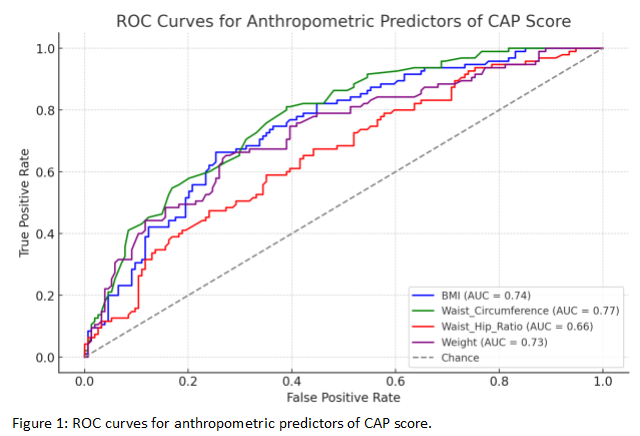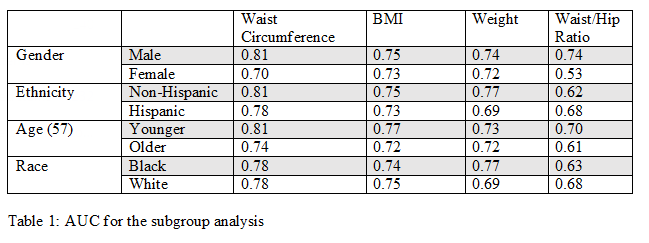Sunday Poster Session
Category: Liver
P1651 - Predicting MASLD in People Living With HIV Using Anthropometric Measures: A Multicenter Cross-Sectional Study
Sunday, October 26, 2025
3:30 PM - 7:00 PM PDT
Location: Exhibit Hall
- MQ
Murad Qirem, MD
New York Medical College - Saint Michael's Medical Center
West Orange, NJ
Presenting Author(s)
Jihad Slim, MD1, Murad Qirem, MD2, Paul Bellafiore, DO1, Bereket Tewoldemedhin, MD1, Tala B. Shahin, MD3, Kevin Leyden, MD4, Ronald Poblete, RN5, Hugo Vargas, MD, FACG3, Sandhya Nagarakanti, MBBS, MD3
1New York Medical College - Saint Michael's Medical Center, Newark, NJ; 2New York Medical College - Saint Michael's Medical Center, West Orange, NJ; 3Mayo Clinic, Phoenix, AZ; 4NJRCRI, Newark, NJ; 5NJRCRI, Phoenix, AZ
Introduction: Metabolic dysfunction-associated steatotic liver disease (MASLD) is prevalent among HIV patients. Currently, diagnostic methods depend on costly imaging or invasive biopsy. Clinic-based anthropometric measures are easily accessible and may provide an alternative for early identification of individuals at risk. This study aimed to determine which anthropometric indicators best predict clinically significant hepatic steatosis in people living with HIV.
Methods: A multicenter, cross-sectional study was conducted at three HIV clinics across the United States. Adults with virologically suppressed HIV (viral load < 200 copies/mL) and without chronic hepatitis B/C or excessive alcohol use (AUDIT >5) underwent liver elastography. Controlled attenuation parameter (CAP) values were used to classify participants into two groups: low (S0–S1) and moderate-to-severe (S2–S3) steatosis. Anthropometric data, demographic information, and comorbidities were recorded. Area under the curve (AUC) was calculated to evaluate the predictive performance of BMI, weight, waist circumference, and waist-to-hip ratio.
Results: Of 305 enrolled participants, 249 met inclusion criteria. The sample was predominantly male (68%), with a median age of 57. Among all anthropometric measures, waist circumference demonstrated the highest predictive accuracy for steatosis (AUC 0.78), followed by BMI (AUC 0.74), weight (AUC 0.71), and waist-to-hip ratio (AUC 0.68). Subgroup analyses confirmed that waist circumference was the most consistent predictor across sex, ethnicity, and age groups, with the highest accuracy in females (AUC 0.80) and non-Hispanic individuals (AUC 0.79).
Discussion: Waist circumference is a simple, reliable, and cost-effective predictor of MASLD in people living with HIV, outperforming BMI and other anthropometric measures. Its consistent performance across diverse subgroups underscores its potential utility in routine HIV care settings to identify patients at risk for steatosis and prompt further evaluation or early intervention.

Figure: ROC Curves for Anthropemetric predictors of CAP score

Figure: Table for the subgroup analysis AUC
Disclosures:
Jihad Slim indicated no relevant financial relationships.
Murad Qirem indicated no relevant financial relationships.
Paul Bellafiore indicated no relevant financial relationships.
Bereket Tewoldemedhin indicated no relevant financial relationships.
Tala Shahin indicated no relevant financial relationships.
Kevin Leyden indicated no relevant financial relationships.
Ronald Poblete indicated no relevant financial relationships.
Hugo Vargas indicated no relevant financial relationships.
Sandhya Nagarakanti indicated no relevant financial relationships.
Jihad Slim, MD1, Murad Qirem, MD2, Paul Bellafiore, DO1, Bereket Tewoldemedhin, MD1, Tala B. Shahin, MD3, Kevin Leyden, MD4, Ronald Poblete, RN5, Hugo Vargas, MD, FACG3, Sandhya Nagarakanti, MBBS, MD3. P1651 - Predicting MASLD in People Living With HIV Using Anthropometric Measures: A Multicenter Cross-Sectional Study, ACG 2025 Annual Scientific Meeting Abstracts. Phoenix, AZ: American College of Gastroenterology.
1New York Medical College - Saint Michael's Medical Center, Newark, NJ; 2New York Medical College - Saint Michael's Medical Center, West Orange, NJ; 3Mayo Clinic, Phoenix, AZ; 4NJRCRI, Newark, NJ; 5NJRCRI, Phoenix, AZ
Introduction: Metabolic dysfunction-associated steatotic liver disease (MASLD) is prevalent among HIV patients. Currently, diagnostic methods depend on costly imaging or invasive biopsy. Clinic-based anthropometric measures are easily accessible and may provide an alternative for early identification of individuals at risk. This study aimed to determine which anthropometric indicators best predict clinically significant hepatic steatosis in people living with HIV.
Methods: A multicenter, cross-sectional study was conducted at three HIV clinics across the United States. Adults with virologically suppressed HIV (viral load < 200 copies/mL) and without chronic hepatitis B/C or excessive alcohol use (AUDIT >5) underwent liver elastography. Controlled attenuation parameter (CAP) values were used to classify participants into two groups: low (S0–S1) and moderate-to-severe (S2–S3) steatosis. Anthropometric data, demographic information, and comorbidities were recorded. Area under the curve (AUC) was calculated to evaluate the predictive performance of BMI, weight, waist circumference, and waist-to-hip ratio.
Results: Of 305 enrolled participants, 249 met inclusion criteria. The sample was predominantly male (68%), with a median age of 57. Among all anthropometric measures, waist circumference demonstrated the highest predictive accuracy for steatosis (AUC 0.78), followed by BMI (AUC 0.74), weight (AUC 0.71), and waist-to-hip ratio (AUC 0.68). Subgroup analyses confirmed that waist circumference was the most consistent predictor across sex, ethnicity, and age groups, with the highest accuracy in females (AUC 0.80) and non-Hispanic individuals (AUC 0.79).
Discussion: Waist circumference is a simple, reliable, and cost-effective predictor of MASLD in people living with HIV, outperforming BMI and other anthropometric measures. Its consistent performance across diverse subgroups underscores its potential utility in routine HIV care settings to identify patients at risk for steatosis and prompt further evaluation or early intervention.

Figure: ROC Curves for Anthropemetric predictors of CAP score

Figure: Table for the subgroup analysis AUC
Disclosures:
Jihad Slim indicated no relevant financial relationships.
Murad Qirem indicated no relevant financial relationships.
Paul Bellafiore indicated no relevant financial relationships.
Bereket Tewoldemedhin indicated no relevant financial relationships.
Tala Shahin indicated no relevant financial relationships.
Kevin Leyden indicated no relevant financial relationships.
Ronald Poblete indicated no relevant financial relationships.
Hugo Vargas indicated no relevant financial relationships.
Sandhya Nagarakanti indicated no relevant financial relationships.
Jihad Slim, MD1, Murad Qirem, MD2, Paul Bellafiore, DO1, Bereket Tewoldemedhin, MD1, Tala B. Shahin, MD3, Kevin Leyden, MD4, Ronald Poblete, RN5, Hugo Vargas, MD, FACG3, Sandhya Nagarakanti, MBBS, MD3. P1651 - Predicting MASLD in People Living With HIV Using Anthropometric Measures: A Multicenter Cross-Sectional Study, ACG 2025 Annual Scientific Meeting Abstracts. Phoenix, AZ: American College of Gastroenterology.
